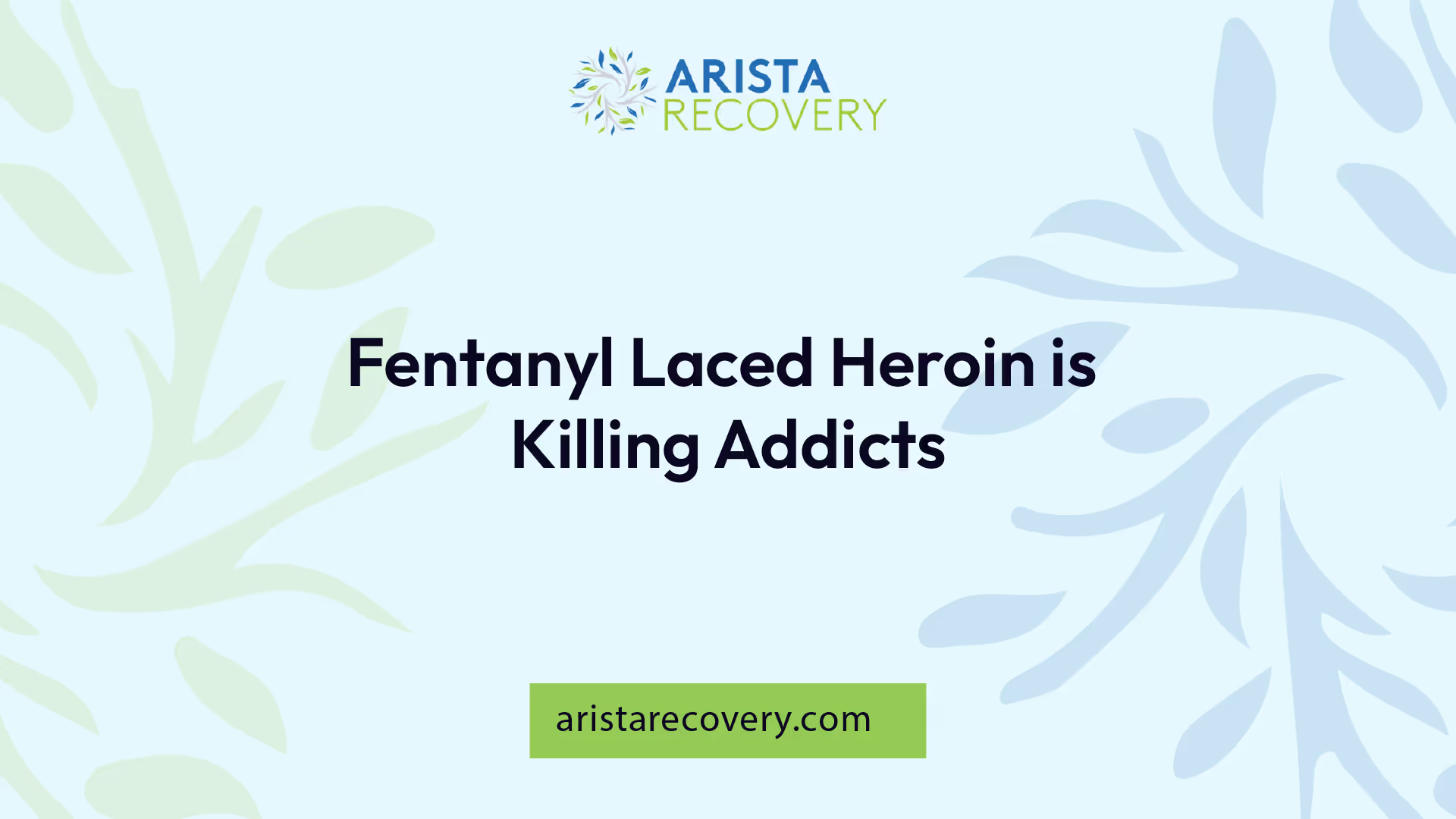Fentanyl Laced Heroin is Killing Addicts

Fentanyl Crisis Overview
The fentanyl crisis has become a major public health concern in the United States, largely due to the rise of synthetic opioids. This issue impacts many, especially those battling addiction.
Impact of Synthetic Opioids
Synthetic opioids, including fentanyl, are now the most common drugs involved in drug overdose deaths in the United States [1]. Their potent effects make them highly dangerous, especially for individuals with a history of substance use. The increased presence of fentanyl in the drug supply has led to a significant rise in fatal overdoses, making awareness and education critical for those affected.

The following table illustrates the increase in overdose deaths involving synthetic opioids over recent years.
YearTotal Overdose DeathsFentanyl-Related Deaths201770,23728,400201867,36729,206201970,63036,359202091,69856,516
Mixing Fentanyl with Drugs
Drug dealers often mix fentanyl with other substances, including heroin, cocaine, methamphetamine, and MDMA. This is done because it takes very little fentanyl to produce a high, making it a cheaper option for dealers [1]. However, this practice significantly increases the risk of overdose for users unaware of the presence of fentanyl in their drugs.
Fentanyl’s potency makes it particularly dangerous when mixed with other drugs. Those struggling with addiction may unknowingly consume lethal doses, leading to severe health consequences or death. It is crucial for individuals in recovery or those using these drugs to understand the risks involved.
For further information on the risks associated with opioid use and strategies for cures of heroin addiction, resources are available that provide guidance for those affected. Understanding these factors can empower individuals to seek help and safer practices in the face of this ongoing crisis.
Understanding Fentanyl Addiction
Fentanyl addiction poses significant risks, especially as it is increasingly mixed with drugs such as heroin. Understanding its potency and the withdrawal symptoms associated with use is critical for those affected by addiction.
Potency and Addiction
Fentanyl is a synthetic opioid that is 50 to 100 times more potent than morphine. This potency contributes to its highly addictive nature, as it can lead to compulsive drug-seeking behavior and usage that individuals find difficult to control, despite facing harmful consequences [1]. Just two milligrams of fentanyl can result in overdose or death, highlighting the dangers associated with its use, especially when mixed with heroin and other drugs [2]. The challenge lies in the fact that fentanyl cannot be easily detected as it has no smell or taste, making it difficult for users to discern whether their drugs are laced with fentanyl without utilizing fentanyl test strips.
Withdrawal Symptoms
Withdrawal from fentanyl can be an extremely uncomfortable experience. Symptoms can be severe and include:
Withdrawal SymptomsRestlessnessMuscle and bone painSleep problemsDiarrhea and vomitingCold flashes with goose bumpsUncontrollable leg movementsSevere cravings
Individuals may experience these withdrawal symptoms when they attempt to stop using fentanyl, making it challenging to quit. The acute nature of these symptoms can lead individuals back to substance use in an effort to relieve their discomfort [1]. For those struggling with addiction, understanding these factors is key in seeking help and exploring options for recovery. Resources, such as information on cures for heroin addiction, can provide valuable support.
Managing Fentanyl Overdose
With the rising danger posed by fentanyl, especially when mixed with heroin, effective strategies for managing overdoses are imperative. This section focuses on the treatment options available, particularly naloxone, and the risks associated with fentanyl overdose.
Naloxone as a Treatment
Naloxone is a critical medication used to combat opioid overdoses, including those caused by fentanyl-laced heroin. It functions by rapidly binding to opioid receptors in the brain, effectively blocking the effects of opioids and reversing the overdose effects. This can be vital in saving lives when someone experiences a fentanyl overdose.
Management of an overdose may require multiple doses of naloxone due to fentanyl's extreme potency. Individuals encountering an overdose situation are advised to call emergency services immediately, even after administering naloxone, as further medical assistance is often needed.
To illustrate the effectiveness and usage of naloxone, consider the following:
ScenarioResultAdminister naloxoneOpioid effects blockedRepeat doses requiredPossible due to potent fentanyl
Educating communities about naloxone and making it readily available can significantly reduce fatalities associated with fentanyl use. For those in need, resources are available to obtain naloxone without a prescription.
Risks of Fentanyl Overdose
Fentanyl poses specific risks due to its high potency. The Drug Enforcement Administration (DEA) reports that six out of ten counterfeit pills contain potentially lethal doses of fentanyl, highlighting the severe risk involved with illicit drug use [3].
Moreover, when fentanyl is mixed with other substances, such as xylazine, which is a non-opioid sedative, naloxone may not be effective in reversing the overdose, leading to increased mortality risks [3].
The surge of "rainbow fentanyl" — brightly colored pills aimed at attracting younger users — further indicates that the threat is evolving. This alarming trend necessitates greater awareness and preventive measures to safeguard individuals against overdose.
Understanding the risks associated with fentanyl and implementing timely interventions are crucial steps in managing cases of overdose, particularly for those entangled in heroin addiction. Recognizing the signs and knowing how to respond can potentially save lives. For anyone affected by opioid addiction, resources and support are vital in navigating this crisis.
Fentanyl-Related Deaths Statistics
Growing Fatality Numbers
The fentanyl crisis has seen alarming increases in related fatalities over the years, particularly due to the combination of fentanyl with other substances such as heroin and cocaine. According to the data, the trend in heroin overdose deaths has surged 2.5-fold from December 1999 to June 2023, indicating a significant rise in deaths associated with fentanyl-laced heroin. This surge underscores the danger that fentanyl poses to those dealing with heroin addiction.
Additionally, the number of deaths involving synthetic opioids continues to escalate. Between August 2021 and August 2022, 107,735 Americans succumbed to drug poisonings, with 66% of those deaths linked to synthetic opioids like fentanyl [3]. The following table summarizes the key statistics of fentanyl-related overdoses:
YearEstimated Deaths from Fentanyl Overdose20204,000 deaths in California alone2022Major contributor to over 107,735 total overdose deaths1999-20232.5-fold increase in heroin overdose deaths
Demographics at Risk
Different demographic groups face varying risk levels when it comes to fentanyl-related fatalities. For instance, in 2019, non-Hispanic American Indians or Alaska Natives had the highest drug overdose death rates, at a staggering 30 per 100,000 individuals, demonstrating significant disparities in the impact of this crisis across racial and ethnic lines.
Particularly concerning is the rising number of deaths among younger populations. Fentanyl-related deaths among individuals aged 10-19 increased dramatically in California, from just 36 cases in 2018 to 261 cases in 2020 [2]. The following table illustrates the demographics affected by fentanyl overdoses:
Demographic GroupDeath Rate per 100,000Non-Hispanic American Indians30Adolescents (Ages 10-19)Significant increase from 36 to 261 between 2018-2020
Understanding these statistics is paramount for raising awareness about the dangers of fentanyl-laced heroin and for developing effective strategies to combat this ongoing public health crisis. For individuals grappling with addiction, resources to address their struggles can be found in articles discussing cures for heroin addiction and how many users transition from prescription painkillers to heroin.
Illicit Fentanyl Distribution
The distribution of illicit fentanyl has become a significant concern in the context of drug-related overdoses, particularly as it intersects with heroin addiction. Understanding the origin and distribution of fentanyl is crucial to grasping its impact on the current opioid crisis.
Origin and Distribution
Illicitly used fentanyl is primarily manufactured in clandestine labs, mostly located outside the United States, particularly in Mexico. These labs produce synthetic opioids that are smuggled into the U.S., contributing to the ongoing epidemic of overdose deaths. The Sinaloa Cartel and Jalisco Cartel are key players in trafficking fentanyl into the United States, sourcing their chemicals from China, which leads to widespread distribution of this potent substance.
Fentanyl is often found mixed with other drugs, such as heroin, methamphetamine, and cocaine, increasing the likelihood of fatal interactions. This dangerous cocktail not only makes the drugs more potent but also makes it extremely difficult for users to gauge the actual dose they are consuming.
SourceContributionsChinaSupplies chemicals for fentanyl productionMexicoClandestine labs manufacturing fentanylU.S.Distribution networks fueled by cartels
Risks of Counterfeit Pills
The risks associated with counterfeit pills containing fentanyl are alarming. Drug dealers often produce counterfeit medications that resemble legitimate pharmaceutical drugs but are laced with fentanyl or other dangerous synthetic opioids. This form of illicit drug distribution poses a significant risk, as many users may unknowingly ingest a lethal dose.
According to the National Institute on Drug Abuse, these counterfeit pills can lead to immediate overdoses and have been tied to an increasing number of fatalities across the country. Users seeking out pain relief or recreational effects may not realize that what they are consuming is not only illegal but potentially deadly.
The growing prevalence of both fentanyl-laced heroin and counterfeit pills highlights the urgent need for a comprehensive approach to address this crisis. For people grappling with addiction, understanding these risks is essential for making informed decisions. For further reading on heroin addiction pathways, visit our articles on how long heroin stay system and heroin addict started by prescription painkillers.
Addressing the Fentanyl Crisis
As the crisis of fentanyl-laced heroin continues, addressing the issue requires a multifaceted approach that includes harm reduction strategies and community and government initiatives.
Harm Reduction Strategies
Harm reduction is a proven approach that aims to minimize the health risks associated with drug use. Organizations and health authorities are implementing several strategies to combat the effects of fentanyl-laced heroin on individuals and communities. One critical element includes the distribution of naloxone, an overdose reversal drug. The FDA is actively supporting the accessibility and development of naloxone and other overdose reversal drugs, encouraging their widespread use.
Moreover, the Substance Abuse and Mental Health Services Administration (SAMHSA) provides funding through harm reduction grants to various governments and organizations for overdose prevention programs and syringe service programs. These initiatives are essential in providing resources to individuals facing addiction issues.
The CDC’s Stop Overdose campaign plays a vital role in educating users about the dangers of illicit fentanyl and mixing drugs. This campaign also promotes the importance of carrying naloxone, aiming to reduce stigma around recovery and treatment options [6]. By raising awareness, these harm reduction strategies aim to decrease overdose fatalities stemming from fentanyl-laced products.
Community and Government Initiatives
Community involvement is crucial in tackling the fentanyl crisis. Local organizations and programs are mobilizing to provide support and resources for individuals struggling with addiction. One effective initiative includes state laws that authorize pharmacists to prescribe naloxone, which has shown to correlate with increased naloxone dispensing in retail pharmacies. This strategy aims to enhance access to life-saving medications and ultimately prevent opioid-related deaths [6].
In addition to community initiatives, governmental bodies are actively working to combat the distribution of illicit fentanyl. Much of this substance is manufactured in clandestine labs, primarily in foreign countries, and smuggled into the United States. Increased awareness and education on the dangers of fentanyl and its often-hidden presence in other drugs could help reduce addiction rates.
Comprehensive efforts from both community organizations and government agencies aim to address the damaging effects of fentanyl laced heroin killing addicts. Through collaboration, education, and support services, these initiatives strive to make a significant impact on the ongoing fentanyl crisis and save lives.
References
[2]:
[3]:
[4]:
[5]:
[6]:
You’re not alone in this.
When mental health challenges and addiction intersect, it can feel isolating. At Arista, we offer compassionate, evidence-based, and trauma-informed care to help you heal, grow, and move forward.
You’re not alone in this.
When mental health challenges and addiction intersect, it can feel isolating. At Arista, we offer compassionate, evidence-based, and trauma-informed care to help you heal, grow, and move forward.
Support that moves with you.
You’ve taken a brave first step. At Arista Recovery, we’re here to help you continue with best-in-class care designed for long-term healing and support.
.webp)






